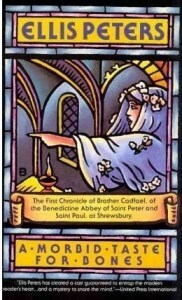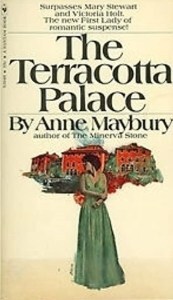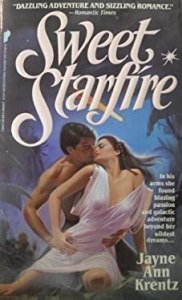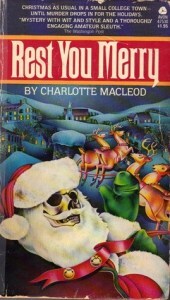What a Writer Reads
 Kaitlyn Dunnett/Kathy Lynn Emerson here, taking a look back at my checkered career and once again finding a convenient topic to blog about. I’ve mentioned before that I’ve been rereading many old favorites since the pandemic began. Let’s face it. There’s nothing like a good comfort read (or escapist fiction, if you will) to take one’s mind off real-world problems.
Kaitlyn Dunnett/Kathy Lynn Emerson here, taking a look back at my checkered career and once again finding a convenient topic to blog about. I’ve mentioned before that I’ve been rereading many old favorites since the pandemic began. Let’s face it. There’s nothing like a good comfort read (or escapist fiction, if you will) to take one’s mind off real-world problems.
Some of the books I chose to lose myself in have penciled-in dates on the flyleaf to indicate when I read that particular novel in the past. A fair number have more than one such notation, and some go as far back as the 1980s. That started me thinking.
I got serious about writing a novel in 1976. I sold my first fiction, a short story for children, in 1980. In 1982, I started using daily planners, a practice I still follow. Along with appointments, I write down what I’m working on, where I’ve submitted a manuscript, and the title of any book I’ve just finished reading. With the exception of reference books, the ones I don’t need to read from cover to cover to find whatever detail I’m looking for, my daybooks contain a record of every book I’ve read for the last forty years.
What a writer reads can’t help but influence what she writes. I’ve written in several genres over those four decades, and when I was just getting started in each new one, I read a lot of books in that genre to get a feel for what worked and what didn’t. From 1982-86, I was heavily into novels written for ages eight to twelves, since the first fiction I sold was for that age group. What I didn’t remember was how many mysteries I was reading in those years, or that they would lay the foundation for what I’d write in the future.
 The titles in those early daybooks include many classic mystery novels—a lot of books by Agatha Christie and Marjorie Allingham with a sprinkling of Ngaio Marsh and Dorothy L. Sayers—but I was also reading romantic suspense, particularly Phyllis A. Whitney, Mary Stewart, and an author most people today probably haven’t heard of—Anne Maybury. At the same time, I was borrowing heavily from my local library, where the mystery collection ran heavily to just a few writers. Some continued to write while others apparently faded away. I discovered Elizabeth Peters and Charlotte MacLeod, both of whom I’ve reread many times, but I also read lots of titles by Anne Morice and Anthea Fraser. With few exceptions, most of what I read fell into the “traditional” category.
The titles in those early daybooks include many classic mystery novels—a lot of books by Agatha Christie and Marjorie Allingham with a sprinkling of Ngaio Marsh and Dorothy L. Sayers—but I was also reading romantic suspense, particularly Phyllis A. Whitney, Mary Stewart, and an author most people today probably haven’t heard of—Anne Maybury. At the same time, I was borrowing heavily from my local library, where the mystery collection ran heavily to just a few writers. Some continued to write while others apparently faded away. I discovered Elizabeth Peters and Charlotte MacLeod, both of whom I’ve reread many times, but I also read lots of titles by Anne Morice and Anthea Fraser. With few exceptions, most of what I read fell into the “traditional” category.
Ellis Peters is another name that frequently crops up in my early daybooks. When I began writing my Face Down series, I consciously copied her regular use of a subplot involving a young couple in love. In many of her books, Brother Cadfael helps the courtship along while also solving the mystery at the center of the novel.

I’ve read this futuristic romance at least seven times since 1989
And speaking of romance, by the late 1980s, I’d discovered category romance (with torrid love scenes!), a relatively new genre at the time. Historical romance was a separate genre, and took longer to catch on. I apparently read 425 books in 1988, most of them romance novels. I still reread authors I discovered way back then—Nora Roberts and Jayne Ann Krentz in contemporary romance and romantic suspense, and Mary Jo Putney and Jo Beverley in historical romance. When I started writing romance myself. I ended up selling ten contemporary romances (nine of them “category” romances for lines like Silhouette Intimate Moments and Bantam Loveswept) and five historical romances.
In skimming through some of my oldest daybooks, it’s clear that most of what I was reading was directly related to what I was about to write. Once I was actively writing in a genre, though, I usually tried to avoid reading other writers in the same genre. I didn’t want my subconscious to start imitating anyone else’s style. Instead, I read in genres I was not writing. Science fiction was an early favorite. In 1985, I read Harry Harrison’s entire Stainless Steel Rat series. Later I tended to read Regency romance. It was highly unlikely I’d ever try to write in either of those genres and they made a nice change from what I was working on. I kept up that practice, more or less, throughout my career. If I was writing cozies, I read historical novels, and vice versa, and sprinkled in between was a lot of romantic suspense.
 Now that I’m semi-retired, I can read anything I want, and I have one big advantage when I decide to reread a book because I enjoyed it in the past: I rarely remember much of the plot, especially if a few years have passed since I last read it, so I don’t have to worry about recalling so much detail that it spoils the story.
Now that I’m semi-retired, I can read anything I want, and I have one big advantage when I decide to reread a book because I enjoyed it in the past: I rarely remember much of the plot, especially if a few years have passed since I last read it, so I don’t have to worry about recalling so much detail that it spoils the story.
Any other re-readers out there? Have you kept track of how many times you’ve reread a favorite book? Is there one you reread at certain seasons? I often reread Charlotte MacLeod’s Rest You Merry as a Christmas treat.
Kathy Lynn Emerson/Kaitlyn Dunnett has had sixty-four books traditionally published and has self published others, including several children’s books. She won the Agatha Award and was an Anthony and Macavity finalist for best mystery nonfiction of 2008 for How to Write Killer Historical Mysteries and was an Agatha Award finalist in 2015 in the best mystery short story category. She was the Malice Domestic Guest of Honor in 2014. Her most recent publications are The Valentine Veilleux Mysteries (a collection of three short stories and a novella, written as Kaitlyn) and I Kill People for a Living: A Collection of Essays by a Writer of Cozy Mysteries (written as Kathy). She maintains websites at www.KaitlynDunnett.com and www.KathyLynnEmerson.com.
Lea Wait's Blog
- Lea Wait's profile
- 509 followers



